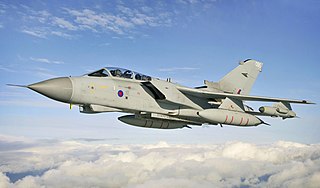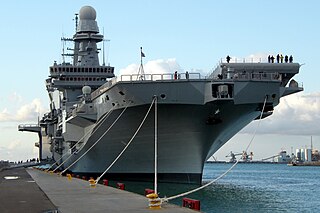
An aircraft carrier is a warship that serves as a seagoing airbase, equipped with a full-length flight deck and facilities for carrying, arming, deploying, and recovering aircraft. Typically, it is the capital ship of a fleet, as it allows a naval force to project air power worldwide without depending on local bases for staging aircraft operations. Carriers have evolved since their inception in the early twentieth century from wooden vessels used to deploy balloons to nuclear-powered warships that carry numerous fighters, strike aircraft, helicopters, and other types of aircraft. While heavier aircraft such as fixed-wing gunships and bombers have been launched from aircraft carriers, these aircraft have not landed on a carrier. By its diplomatic and tactical power, its mobility, its autonomy and the variety of its means, the aircraft carrier is often the centerpiece of modern combat fleets. Tactically or even strategically, it replaced the battleship in the role of flagship of a fleet. One of its great advantages is that, by sailing in international waters, it does not interfere with any territorial sovereignty and thus obviates the need for overflight authorizations from third-party countries, reduces the times and transit distances of aircraft and therefore significantly increases the time of availability on the combat zone.

A bomber is a military combat aircraft designed to attack ground and naval targets by dropping air-to-ground weaponry, launching torpedoes, or deploying air-launched cruise missiles. The first use of bombs dropped from an aircraft occurred in the Italo-Turkish War, with the first major deployments coming in the First World War and Second World War by all major airforces causing devastating damage to cities, towns, and rural areas. The first purpose built bombers were the Italian Caproni Ca 30 and British Bristol T.B.8, both of 1913. Some bombers were decorated with nose art or victory markings.

The Eurofighter Typhoon is a European multinational twin-engine, canard delta wing, multirole fighter. The Typhoon was designed originally as an air-superiority fighter and is manufactured by a consortium of Airbus, BAE Systems and Leonardo that conducts the majority of the project through a joint holding company, Eurofighter Jagdflugzeug GmbH. The NATO Eurofighter and Tornado Management Agency, representing the UK, Germany, Italy and Spain, manages the project and is the prime customer.

The Panavia Tornado is a family of twin-engine, variable-sweep wing multi-role combat aircraft, jointly developed and manufactured by Italy, the United Kingdom and Germany. There are three primary Tornado variants: the Tornado IDS (interdictor/strike) fighter-bomber, the Tornado ECR SEAD aircraft and the Tornado ADV interceptor aircraft.
The Royal Italian Air Force was the name of the air force of the Kingdom of Italy. It was established as a service independent of the Royal Italian Army from 1923 until 1946. In 1946, the monarchy was abolished and the Kingdom of Italy became the Italian Republic, whereupon the name of the air force changed to Aeronautica Militare.

The Italian Air Force is the air force of the Italian Republic. The Italian Air Force was founded as an independent service arm on 28 March 1923 by King Victor Emmanuel III as the Regia Aeronautica. After World War II, when Italy became a republic following a referendum, the Regia Aeronautica was given its current name. Since its formation, the service has held a prominent role in modern Italian military history. The acrobatic display team is the Frecce Tricolori.

The ATR72 is a twin-engine turboprop, short-haul regional airliner developed and produced in France and Italy by aircraft manufacturer ATR, a joint venture formed by French aerospace company Aérospatiale and Italian aviation conglomerate Aeritalia. The number "72" in its name is derived from the aircraft's typical standard seating capacity of 72 passengers.

Giuseppe Garibaldi is an Italian aircraft carrier, the first through-deck aviation ship ever built for the Italian Navy, and the first Italian ship built to operate fixed-wing aircraft. She is equipped with short take-off and vertical landing (STOVL) aircraft and helicopters. Giuseppe Garibaldi was involved in combat air operations off Somalia, Kosovo, Afghanistan and Libya.

The Sequoia Falco is an Italian-designed lightweight 2-seater aerobatic aircraft.

Cavour is an Italian aircraft carrier launched in 2004. She is the flagship of the Italian Navy.

The AMX International AMX is a ground-attack aircraft jointly developed by Brazil and Italy. The AMX is designated A-11 Ghibli by the Italian Air Force and A-1 by the Brazilian Air Force. The Italian name, "Ghibli", is taken from the hot dry wind of the Libyan desert.
Stelio Frati was an Italian mechanical engineer and aeroplane designer. He graduated from the Politecnico of Milan as a mechanical engineer in 1943, participating in the design of the Aeronautica Lombarda AR radio-controlled wooden cantilever monoplane, powered by a single radial engine - a flying bomb/drone, flown for the first time the same year. After teaching aircraft design he became a freelance aircraft designer, being responsible for many well known aircraft designs. One of his best known designs is the Falco F8L.

The Austro-Hungarian Aviation Troops or Imperial and Royal Aviation Troops were the air force of the Austro-Hungarian Empire until the empire's demise in 1918; it saw combat on both the Eastern Front and Italian Front during World War I.
Aviamilano Costruzione Aeronautiche was an Italian aircraft manufacturer established in Milan in the early 1950s. It was the original manufacturer of Stelio Frati's Falco light aircraft, although when production did not run as smoothly as Frati liked, he took the design to Aeromere instead. Aviamilano's staple product was the Scricciolo trainer built for the Aero Club d'Italia from 1959 onwards. The firm's final product was another Frati design, the F.250, rights to which were sold to SIAI-Marchetti in 1964. The firm closed in 1968 after the death of its Managing Director and the rights to the few sailplanes then in production were bought by Caproni Vizzola.

The McDonnell DouglasAV-8B Harrier II is a single-engine ground-attack aircraft that constitutes the second generation of the Harrier family, capable of vertical or short takeoff and landing (V/STOL). The aircraft is primarily employed on light attack or multi-role missions, ranging from close air support of ground troops to armed reconnaissance. The AV-8B is used by the United States Marine Corps (USMC), the Spanish Navy, and the Italian Navy. A variant of the AV-8B, the British Aerospace Harrier II, was developed for the British military, while another, the TAV-8B, is a dedicated two-seat trainer.

Capriolo, later called Aeromere, was the name of the motorcycle production arm of the Italian aircraft company Aeromere or Aero-Caproni. After World War II, the victorious Allies prohibited wartime aircraft and other military hardware suppliers from remaining in their previous industries, and Aero-Caproni would change its name to Capriolo and become one of several, including Aermacchi, MV Agusta, Vespa and Ducati, that switched to producing motorcycles or scooters. These companies did well until the mid-1960s, when the advent of affordable cars like the Fiat 500 removed the economic barrier that kept many Italians relying on motorcycles for basic transportation. Capriolo was typical of those that could not survive the transformation to a more export-orientated industry, with the US as the most important market. Motorcycle production ran from 1947 or 1948 until 1964.
The Pasotti F.6 Airone was a low-wing, twin-engined, wooden, four seat civil aircraft built in Italy in the 1950s. Production was considered but only one was completed.












